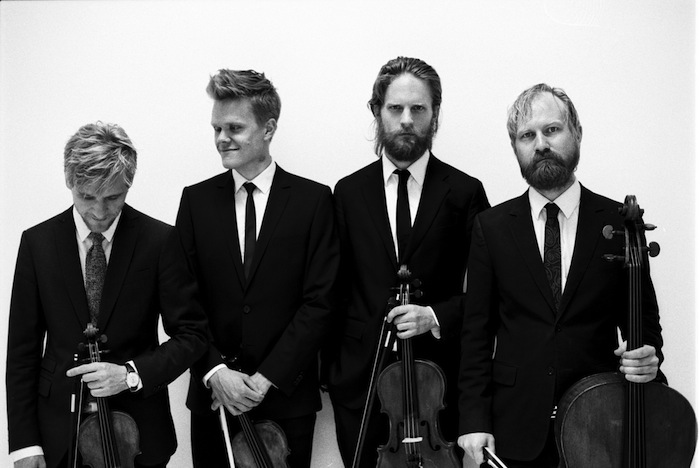Danish Quartet offers a probing look at final things with Schubert and Shostakovich

The Danish String Quartet performed Wednesday night at Zankel Hall. Photo: Caroline Bittencourt
Though the Danish String Quartet’s concert in Zankel Hall on Wednesday night had no title, its central theme was hard to miss. Their pairing of Shostakovich’s String Quartet No. 15 and Schubert’s C-Major Quintet showed a certain morbid fascination, but the musical power of these pieces–not to mention the two very different visions of finality that they represent–made for an exceptionally rewarding program.
By far the darker of the two pieces, Shostakovich’s last quartet is explicit in its death fixation, ruminating grimly for thirty-five minutes. Its tempo indications (Adagio–Adagio–Adagio–Adagio–Adagio molto–Adagio) themselves seem to hint that there is but one thought occupying the composer’s imagination. Even so, Shostakovich finds a variety of emotional states within his steady pace, and the Danish players offered a penetrating reading of the piece’s intricacies.
In the early going, the music seemed less about distinct instruments than about slowly and meticulously weaving a fine texture. Even when a distinct melodic line emerged, it was inseparable from its context, the focal point in a complex image. The ironically titled “Serenade” was harrowingly cold, opening with ghastly, gasping darts, violent expressions of the gruesome process of death. Even beyond the title, there is a dark humor in this movement, as shades of a waltz make themselves heard in the cheeky melody that ensues.
The funeral march shows almost more rage than grief, calling on the performers to dig in fiercely, and grind their way through the first iterations of the theme. To their credit, the Danish Quartet embraced the harshness of Shostakovich’s aesthetic, allowing themselves to force the sound for artistic effect.
Schubert’s String Quintet in C Major is, of course, a work of an entirely different character, but it has its own association with mortality. Finished months before the composer’s death, it naturally exhibits the bittersweet nostalgia that is Schubert’s trademark while expressing the pain of loss more keenly than in many of his other works.
The shining chords that open the piece were beautifully realized. The Danes, with the addition of the Swedish cellist Torleif Thedéen, took a deliberate pace in the introduction, leaving plenty of room to drive towards the climactic moment that so tenderly resolves into the movement’s main theme—one of the most memorable that the great melodist ever wrote. This simple, flowing air of stepwise motion, needs little adornment, and these players allowed it to breathe on its own.
Minor though they were, a few blemishes dotted the performance—for one thing, the five could have stood to tune more carefully, especially in the first movement, where Schubert’s close counterpoint leaves iffy intonation exposed. Nor were they all on the same page concerning their vibrato; first violinist Rune Tonsgaard Sørensen tended to vibrate more narrowly and slowly than his colleagues, which often left the melodic line dry—a problem only compounded by the flat acoustic of Zankel Hall.
Still, the ensemble as a whole played with remarkable warmth, which was most evident in the sighing haze of the Adagio. Its placid opening, moving slowly through a progression of soft colors, was pure bliss, ultimately giving way to the intense grief of the B section. This is the only stretch of the quintet that exhibits the same kind of vivid pain as we’d heard in the Shostakovich. The performers read the music with passion, wrenching every bit of suffering from its aching pulses.
Their rough-around-the-edges approach was especially winning in the Scherzo, lending a boisterous, youthful abandon to the movement’s bounding excitement. The two cellists were particularly rowdy, digging in without too much concern for the purity of their sound. The closing Allegretto, by contrast, was all elegance, bringing the monumental work to a lively conclusion.
Though no encore seemed necessary after such a rich program, the five musicians offered a brief item from home: Carl Nielsen’s song “Underlige aftenlufte,” in an arrangement by violinist Sørensen. The enchanting melody sounded hymn-like in their realization, played with reverence and glowing tone.






